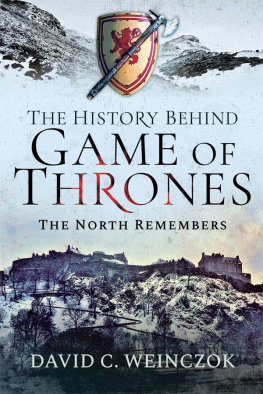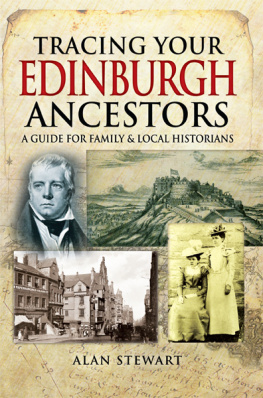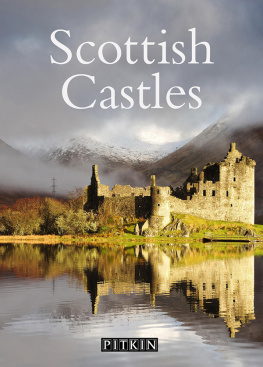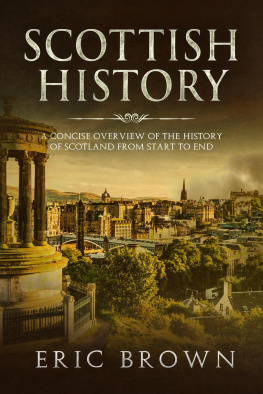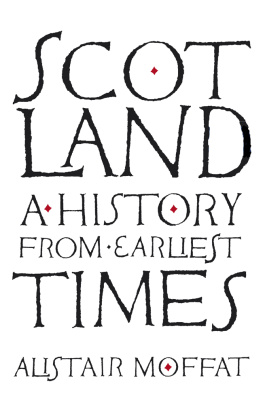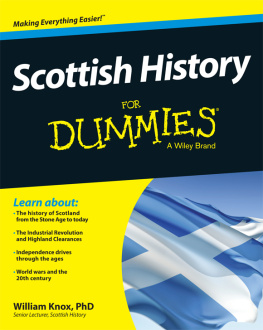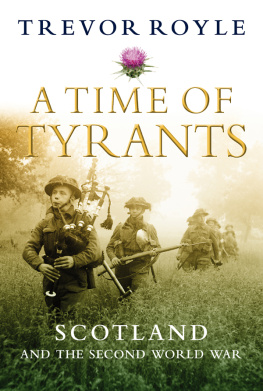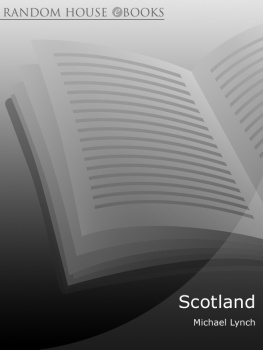Pagebreaks of the print version

THE HISTORY BEHIND
GAME OF THRONES
THE NORTH REMEMBERS
For my parents, who always kept good books around to stoke my
imagination. And for Mr Paul Brown, my high school history teacher
at Donald A. Wilson Secondary School in Whitby, Canada, who lifted
history off the page and made it fun.
A story gives delight to read
Though it be fabulous indeed.
Then should a story that is true,
And told in skilful manner too,
Give pleasure that is full twofold.
- John Barbour, The Bruce
THE HISTORY BEHIND
GAME OF THRONES
THE NORTH REMEMBERS
DAVID C. WEINCZOK

First published in Great Britain in 2019 by
PEN AND SWORD HISTORY
An imprint of
Pen & Sword Books Ltd
Yorkshire Philadelphia
Copyright David C. Weinczok, 2019
ISBN 9781526749017
eISBN 9781526749017
Mobi ISBN 9781526749024
The right of David C. Weinczok to be identified as Author of this work has been asserted by him in accordance with the Copyright, Designs and Patents Act 1988.
A CIP catalogue record for this book is available from the British Library.
All rights reserved. No part of this book may be reproduced or transmitted in any form or by any means, electronic or mechanical including photocopying, recording or by any information storage and retrieval system, without permission from the Publisher in writing.
Pen & Sword Books Limited incorporates the imprints of Atlas, Archaeology, Aviation, Discovery, Family History, Fiction, History, Maritime, Military, Military Classics, Politics, Select, Transport, True Crime, Air World, Frontline Publishing, Leo Cooper, Remember When, Seaforth Publishing, The Praetorian Press, Wharncliffe Local History, Wharncliffe Transport, Wharncliffe True Crime and White Owl.
For a complete list of Pen & Sword titles please contact
PEN & SWORD BOOKS LIMITED
47 Church Street, Barnsley, South Yorkshire, S70 2AS, England
E-mail:
Website: www.pen-and-sword.co.uk
Or
PEN AND SWORD BOOKS
1950 Lawrence Rd, Havertown, PA 19083, USA
E-mail:
Website: www.penandswordbooks.com
Introduction
Never underestimate the power of a story. When the very first story was told, perhaps about some great hunt or a land of plenty and promise over the farthest hill, the world of the people who heard it became a grander place. They passed the story on to their children and their childrens children, and eventually some of them found the courage to seek out the truth of it. Whether or not they succeeded is immaterial. The point is that they went searching.
When we fill our world with stories it becomes impossible to be bored. Certainly not in Scotland, the nation whose history this book is dedicated to. Walking the streets of Edinburgh, even if for the thousandth time, is to be immersed in an epic for the ages. The indomitable castle and scene of the Black Dinner looms over it all, the rock upon which countless armies have crashed. And what of the peak of Arthurs Seat, that mighty lion in repose, that reminds all who look upon Edinburgh even from many miles away that Scotlands story is one of the primordial clash between ice, fire and stone? Can we get closer to the Starks than by sitting astride the bewitching branches of the yew tree growing within the courtyard of Craigmillar Castle, the real-life Winterfell? How many of the students of the University of Edinburgh who drink and study in the nearby Meadows are aware that, had they been on that very spot 2,000 years ago, they would have witnessed Agricolas legions marching north to take the fight to the Caledonians beyond the Antonine Wall? Stories and history is, after all, a collection of stories are ultimately tools for understanding and forging connections to our own world. One of the greatest legacies of Game of Thrones is how it has got millions of people across the world thinking about and enjoying history. It may be the history of a world that happens to not in fact exist, but as this book will argue, George R.R. Martin built it around a framework firmly rooted in real events, individuals and concepts.
In telling the story of A Song of Ice and Fire , George R.R. Martin has set innumerable people across the globe upon their own journeys of curiosity and wonder, and that alone makes it an invaluable tool for educators and storytellers. Some may begrudge the idea of learning Scottish or any other sort of history through the lens of popular culture. An all too common complaint about tourists in Scotland, for instance, is that they are just here because they watched films like Braveheart or Highlander . Yet such complaints warrant no attention, for there is a long and proud tradition of popular culture setting the worlds sights on Scotlands story. If we somehow found ourselves in the 1810s rather than the 2010s, we would be impatiently waiting for the release of the next Waverley novel by Walter Scott rather than Martins The Winds of Winter . The release of Ivanhoe in 1819, a mere one year after Rob Roy , was met with intense speculation and rabid enthusiasm. Many a Romantic would be compelled by these and other novels to meander through the medieval streets of Edinburgh or study the ruins of Craignethan Castle, which became Tillietudlem Castle in Scotts Old Mortality , in the hope of coming closer to the essence of the tales they loved.
Fictional stories have also given some historic sites a new lease of life. Craignethan underwent a conservation programme in the nineteenth century as a result of renewed interest due to Scotts writings, and Doune Castle north of Stirling went from a beautiful but obscure ruinous keep to a beloved place of pilgrimage for pop culture devotees, having been used as a filming location for Monty Python and the Holy Grail , the television series Outlander and, not least, for the pilot episode of Game of Thrones where the Starks welcomed King Robert Baratheon and the Lannisters to Winterfell. At many historic locations in Scotland where the architecture has begun to crumble or the prestige of a place has long since receded, the telling of stories has restored them to their former glory and beyond.
A great pub quiz could be based around the superficial similarities between the histories of Westeros and our own world. Knowing that there is a region in the north-west Highlands called Wester Ross, or that the noble houses of Stark and Lannister sound an awful lot like the houses of York and Lancaster from the Wars of the Roses, would surely earn you some points in it. It is also fun to know trivia about the cast, for example that Rose Leslie, who plays Ygritte, is in fact part of an aristocratic Scottish family who own Wardhill Castle in Aberdeenshire, or that Rory McCann, who plays Sandor Clegane, was once the kilted and shirtless star of adverts for Scotts Porage Oats, a popular brand of Scottish porridge. Yet to think that the historical parallels and Scottish connections go only skin deep not only deprives you of much more interesting and useful knowledge, it vastly underestimates the extent to which George R.R. Martin has taken pains to create a fantastical world that not only reflects real history but actually enhances our understanding and appreciation of it. History done wrong can be a dreadful slog; throw in a few dragons and ice zombies, however, and suddenly a history lesson can become a global phenomenon.

